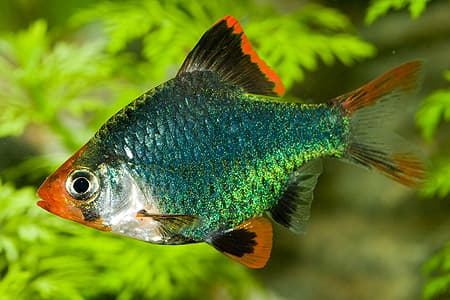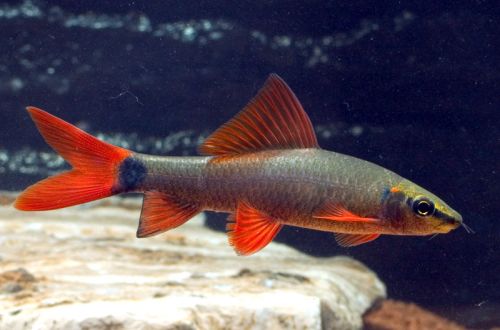
Betta Dennisa Yonga
Dennis Yong’s Betta or Dennis Yong’s Cockerel, scientific name Betta dennisyongi, belongs to the Osphronemidae family. The fish is named after the Indonesian naturalist and explorer Dennis Yong Ghong Chong, who discovered and described many fish species that inhabit the Greater Sunda Islands. Not the easiest fish to keep, but its behavioral features make it difficult to choose compatible species. Not recommended for beginner aquarists.

Contents
Habitat
It comes from Southeast Asia from the northern tip of the island of Sumatra (Aceh Province, Indonesia). The natural habitat is located among the hilly terrain. Fish inhabit small rivers and streams flowing down from the hills, as well as swamps enclosed between hills. A typical biotope is a stagnant or flowing body of water with substrates of sand, clay, and a thick layer of silt covered with a layer of fallen leaves, twigs, and other plant material. The water has a brownish tint due to the high concentration of humic acids and other tannins released as a result of the decomposition of plant organic matter.
Brief information:
- The volume of the aquarium – from 40 liters.
- Temperature – 22-27°C
- Value pH — 5.0–7.0
- Water hardness – 1–5 dGH
- Substrate type – any dark
- Lighting – subdued
- Brackish water – no
- Water movement – little or no
- The size of the fish is about 3 cm.
- Food – any food
- Temperament – peaceful
- Content – alone, in a pair or group with a male and several females
Description
There is some confusion regarding the appearance of these fish. Until 2013, they were considered a variety of another related species, the Red Betta, which was later isolated as an independent species. Both fish were supplied in the same batches and kept together, which led to the appearance of hybrid offspring that inherited the features of both species. It is this offspring and their descendants that are currently on sale.
True Betta Dennis Young reach a length of about 3 cm. Males, unlike females, are somewhat larger, the color is gray with a light horizontal stripe stretching from head to tail. On the body and fins, red shades are noticeable. In hybrids, red vertical strokes appear on the sides. Females are more modestly colored, the main colors are gray.
Food
Bettas grown in the artificial environment of aquariums have adapted to feeding on dry food in the form of flakes and granules. The most preferred diet is a combination of dry, frozen and live foods such as brine shrimp, daphnia, bloodworms, etc.
Maintenance and care, arrangement of the aquarium
The optimal size of the aquarium for one pair of fish starts from 40 liters. Can be kept in a semi-empty or fully decorated aquarium, although many breeders choose not to use a substrate for ease of maintenance. The presence of decor is still welcome, Petushki will look more harmonious in an environment resembling a natural reservoir. Set the lighting to low and create diffused light with floating plants. Natural snags and clusters of aquatic mosses and ferns can form several shaded areas that act as shelters. Adding the dried leaves of some trees to a dark substrate will give a natural look to the aquarium. If the design does not matter, then any decorative objects are suitable as shelters, as well as ceramic pots turned over on their side, fragments of PVC pipes, etc.
Long-term successful keeping is only possible in a stable aquatic environment with low pH and dGH values. During water treatment when filling the aquarium or when carrying out maintenance procedures (weekly replacement of part of the water with fresh water), in regions with hard water, it may be necessary to purchase additional devices, such as a reverse osmosis system. You can also use the recommendations for reducing hydrochemical values, described in one of our articles.
Use filters that do not cause excessive water movement. Being native to stagnant water bodies, Bettas are not adapted to life in strong currents. And the main reason for the welterweight is precisely the filtering system. In a small tank with a couple of fish, a simple airlift filter with a sponge will suffice.
Behavior and Compatibility
Belongs to the group of fighting fish. Males are not very friendly towards each other. Clashes are not uncommon. Competition intensifies when space is scarce. Although the likelihood of injury is minimal, the weaker individual will be forced to hide and be on the periphery of the aquarium. In small tanks, it is desirable to maintain groups of one male and several females. It is worth noting that other types of similar coloring may also be attacked by males. However, given Dennis Young’s Betta’s modest size, larger fish are nothing to worry about.
Breeding / breeding
Betta fish from the Greater Sunda Islands (Sumatra, Borneo, Java, Sulawesi) are characterized by a method of reproduction with the bearing of fertilized eggs in the mouth. And this is done exclusively by the male. Such a strategy ensures high survival of juveniles with a relatively small number of eggs.
With the onset of the mating season, the dominant male (if there are several) begins active courtship, forming a temporary pair with one of the females. During spawning, accompanied by close hugs, when the fish seem to wrap themselves around each other, the female alternately releases several eggs, which, after fertilization, are immediately picked up by the male. At the end of spawning, the male retires, trying to find the most secluded place – shelters will come in handy here. The fry appear after 10-17 days. They are fully formed and from the first days of life they begin to swim in search of food. A good choice would be specialized foods for juvenile aquarium fish, as well as live foods such as brine shrimp nauplii. For the safety of the brood, it is better to move it to a separate container. And although the parents do not rearrange the dangers for their fry, other fish will consider them as a source of food.
Fish diseases
The cause of most diseases is unsuitable conditions of detention. A stable habitat will be the key to successful keeping. In the event of symptoms of the disease, first of all, the quality of the water should be checked and, if deviations are found, measures should be taken to correct the situation. If symptoms persist or even worsen, medical treatment will be required. Read more about symptoms and treatments in the Aquarium Fish Diseases section.





